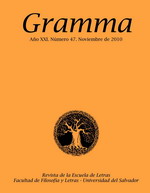The Motif of the Double in «William Wilson», of Edgar Allan Poe, and «Dos Imágenes en un Estanque», of Giovanni Papini
Keywords:
Papini, Poe, double, Wilson, pondAbstract
If there are any questions that have troubled mankind from the remotest times, these are who we are and whether we really are those who we believe we are. Literature has tried to answer these questions in several ways and, as one of the results of this deep inquiry, has emerged, primarily in the context of literary romanticism, the motif of the double, or doppelganger, which, after several variations, has continued growing until today.The aim of this research work consists in the comparative analysis of two short stories, enlightened by the proposed theme: «William Wilson» (1837) by Edgar Allan Poe (1809-1849), one of the foundational stories that dealt with this motif, and «Two images in a pond» (1907) by Italian writer Giovanni Papini (1881-1956). Although Papini’s fantastic tales show a clear influence from Poe, it is not our goal to trace it, nor detail any possible intertextuality, but simply show how various aspects of a motif so universal as the doppelgänger can be renewed, with contact points and divergence, by authors from different nations, periods and sensitivities.Published
How to Cite
Issue
Section
License
Works published in this journal are licensed under a Creative Commons Attribution-NonCommercial-
Works published under this licence may be shared, copied and redistributed in any medium or format. Adaptation, remixing, transformation and creation are also authorised. Both sharing and adapting are permitted as long as credit is given to the work appropriately, providing a link to the licence and indicating whether changes have been made. Commercial use of the material is also not possible.








